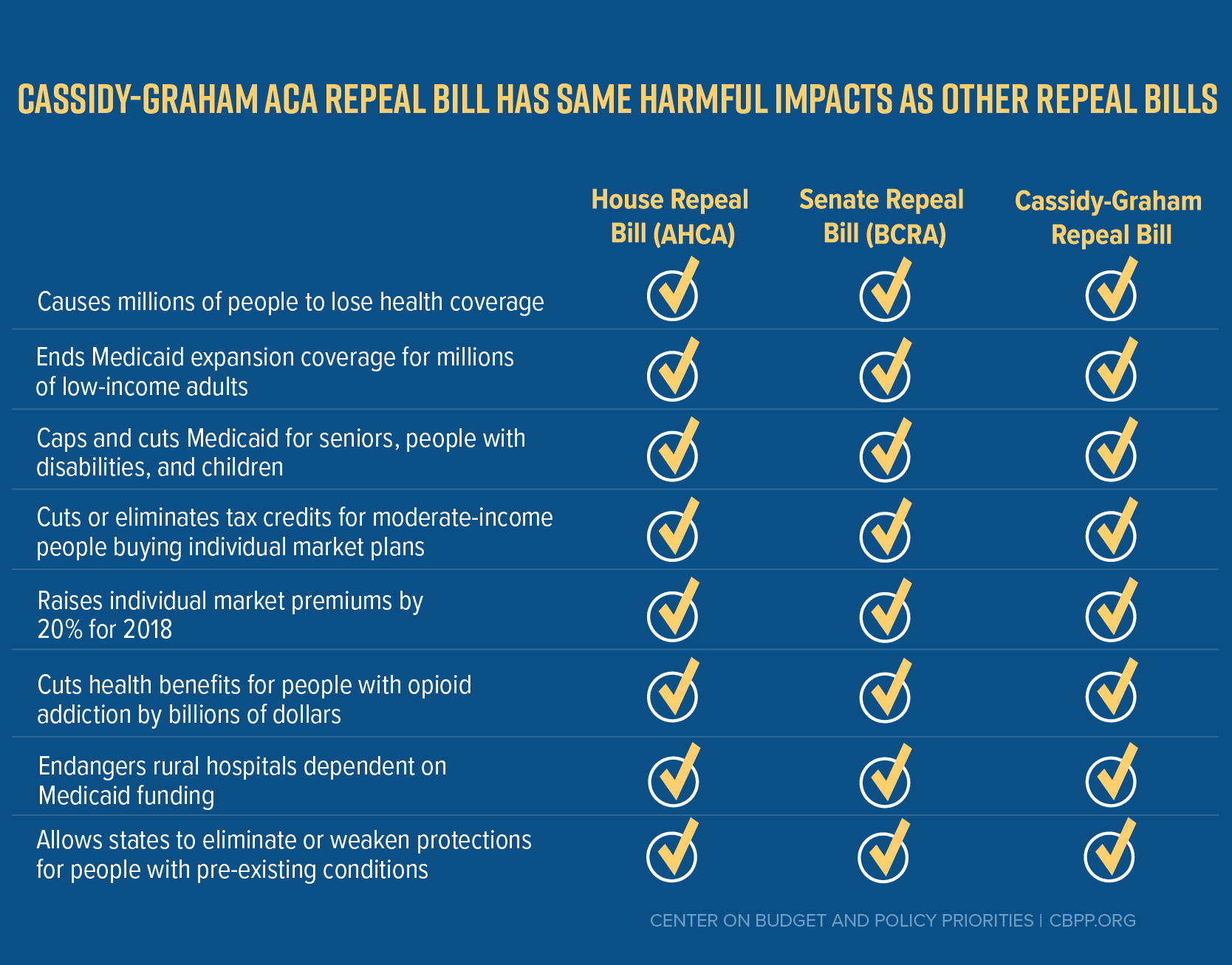Updated September 20, 2017.
At first glance it may look like Texas comes out ahead in the Graham-Cassidy bill, the Senate’s last-ditch effort to cut Medicaid and repeal the Affordable Care Act (ACA), but that is only if one considers just a narrow portion of the bill – short-term block grant funding. Taken as a whole, the bill is very bad for Texans, both in the short-term and beyond.
A block grant would disconnect federal funding from the number of Medicaid beneficiaries and the cost of providing care. The Federal contribution would grow only according to a preset formula, no matter how large the population in need becomes, or how much a state actually must spend on health care and long-term care for Medicaid recipients.
 Graham-Cassidy takes the current funding for Medicaid expansion (to 31 states) and Marketplace subsidies, lumps them together into a block grant, cuts the funding more each year (reduction of 17% in 2026), and then re-distributes it essentially from states with Medicaid expansion and/or high rates of Marketplace enrollment to the other states. On the surface, Texas appears to come out ahead in this narrow focus on just the block-grant redistribution before 2027.
Graham-Cassidy takes the current funding for Medicaid expansion (to 31 states) and Marketplace subsidies, lumps them together into a block grant, cuts the funding more each year (reduction of 17% in 2026), and then re-distributes it essentially from states with Medicaid expansion and/or high rates of Marketplace enrollment to the other states. On the surface, Texas appears to come out ahead in this narrow focus on just the block-grant redistribution before 2027.
Reliable sources, including the Center on Budget and Policy Priorities and Avalere Health have projected Texas would see increased federal funding from 2020-2026 under this bill. But, as CBPP and others point out, there’s much more to the story:
- All block funding goes away after 2026. To keep federal health care dollars available and coverage intact in 2027 and beyond, Congress would have to come up with an estimated $200 billion each year in offsets or revenues to keep pace. This sets up a funding cliff that Congress is unlikely to be able to afford to fill. Experts expect that in 2027, more than 32 million people will have lost coverage under the bill.
- Once the block grant expires and Medicaid per capita growth rates are cut, Texas’ federal funding plummets, swinging from a $34 billion gain from 2020-2026, to a net loss of $120 billion federal dollars from 2020-2036.
- States could spend the shrinking block grant funding on any health care purpose with no guarantee of coverage or affordable care for lower-income individuals. The short-term increase in federal funding to Texas does not have to translate to improved access to coverage for low- and moderate-income Texans. If Texas chooses to use some of the block grant from Graham-Cassidy on coverage, it would have to set up a coverage program from scratch by 2020 and there is no federal fallback to ensure continuing coverage to the residents in states that do not have state programs up and running in time.
- The amount Texas would gain through Graham-Cassidy is far less than Texas could gain from maximizing our coverage under the ACA. Multiple expert sources (including Texas Medicaid officials ) have projected Texas would gain more than $10 billion a year in federal funds from the ACA Medicaid Expansion, with the federal funds helping Texans afford Marketplace premiums and out-of-pocket costs adding another $4 billion a year (in 2022) to that amount.

The block grant is just one piece of Graham-Cassidy. Outside of the block grant, the rest of the bill is terrible for Texas too:
- Graham-Cassidy separately caps and cuts the existing Medicaid program. Medicaid is the backbone of our health care system. In Texas, Medicaid pays for more than half of all births, covers more than 40 percent of all children, and pays for the care of two-thirds of people in nursing homes. Medicaid funding helps keep rural hospitals open and the safety net intact. Cuts to the traditional (non-expansion) Medicaid program in Graham-Cassidy will be very harmful to Texas and result in substantial cuts to our existing Medicaid program that serves low-income kids, pregnant women, individuals with disabilities, and seniors. The “per-capita cap” cut will reduce federal Medicaid spending by 8% in 2026, but that cut grows much faster into the future after growth rate is reduced dramatically in 2025. We took a closer look at similar Medicaid cuts in earlier, rejected bill versions here and here.
- Graham-Cassidy separately ends the individual mandate immediately, throwing the individual market (including the Marketplace) into chaos next year. Similar ACA repeal bills show premiums spiking immediately in the individual market and coverage options dwindling, threatening access to coverage for all 1.8 million Texans who rely on the individual market.
- Graham-Cassidy separately lets states opt out of key ACA consumer protections that ensure people with pre-existing conditions can’t be charged more and that health insurance policies cover essential benefits – like maternity care, medications, mental health care, and substance use disorder treatment. We took a closer look here at what losing these key consumer protections would have meant in earlier, rejected versions of ACA repeal.
Complete consequences of bill will NOT be known before any vote.
The Congressional Budget Office announced that it will release a limited analysis of Graham-Cassidy during the week of September 25, but it will be unable to do a full analysis on the Senate’s rushed timeline. The Senate will not have information on how many millions of Americans will lose coverage, what will happen to premiums and out-of-pocket costs, and how the bill affects the stability of the individual market. The Senate had this complete picture on all previous bill drafts before voting. The Senate’s rushed consideration will prevent the Senate and the public from fulling understanding the extent of harm the bill will cause.
